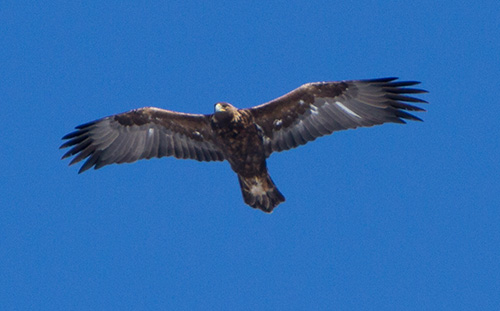
Weather reroutes golden eagle migration in AlaskaBy SONNARY CAMPBELL
November 07, 2018
Their study sheds light on how eagles choose migration routes and how that might affect eagles’ use of routes in the future as climate changes. UAF Ph.D. student Joe Eisaguirre, the study’s lead author, collaborated with researchers at UAF, the Alaska Department of Fish and Game, the National Park Service and the U.S. Fish and Wildlife Service.
They spent many years tracking eagles tagged with radio transmitters. The data revealed that weather plays a major role in whether migrating eagles navigate north or south of the Wrangell Mountains, one of the tallest ranges in North America. The collaborators began the project to understand the movement of adult migratory golden eagles that breed in Alaska and how they might interact with wind energy developments, primarily outside of Alaska. “We knew very little, not even where they go after leaving Alaska in the fall,” Eisaguirre said. Adult golden eagles had never been tagged with transmitters in Alaska. During migrations, animals make countless decisions as they move across the landscape. As weather and climates change, animal choices at numerous points along migration routes would be expected to create different overall migration patterns. “We might be able foresee some of those changes if we can figure out how to predict changes in animal decision-making processes, as we did with this study,” Eisaguirre said. Having such information could help reduce human impacts on animals. The information on the golden eagles’ choices, for example, could be used in deciding where to place wind turbines now and in the future. The study was published this week in the Proceedings of the Royal Society B, the society’s journal for biological research. Eisaguirre’s collaborators on the paper were Travis Booms and Chris Barger of the Alaska Department of Fish and Game; Carol McIntyre of the National Park Service; Steve Lewis of U.S. Fish and Wildlife Service; and Greg Breed, assistant professor at the UAF Institute of Arctic Biology.
|
|||||
